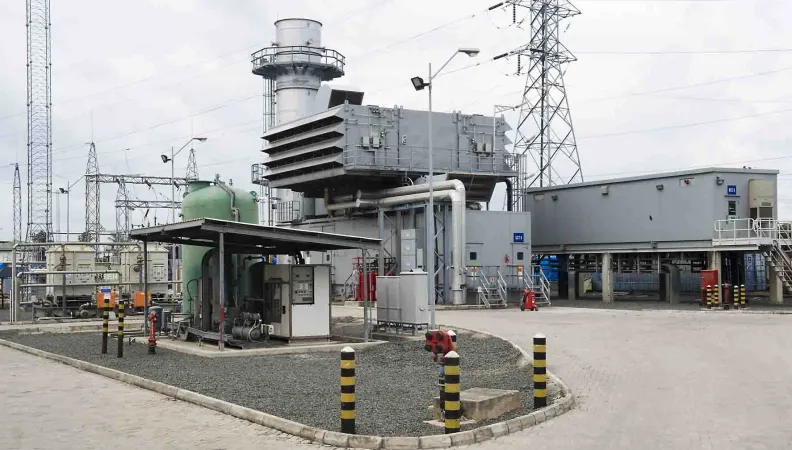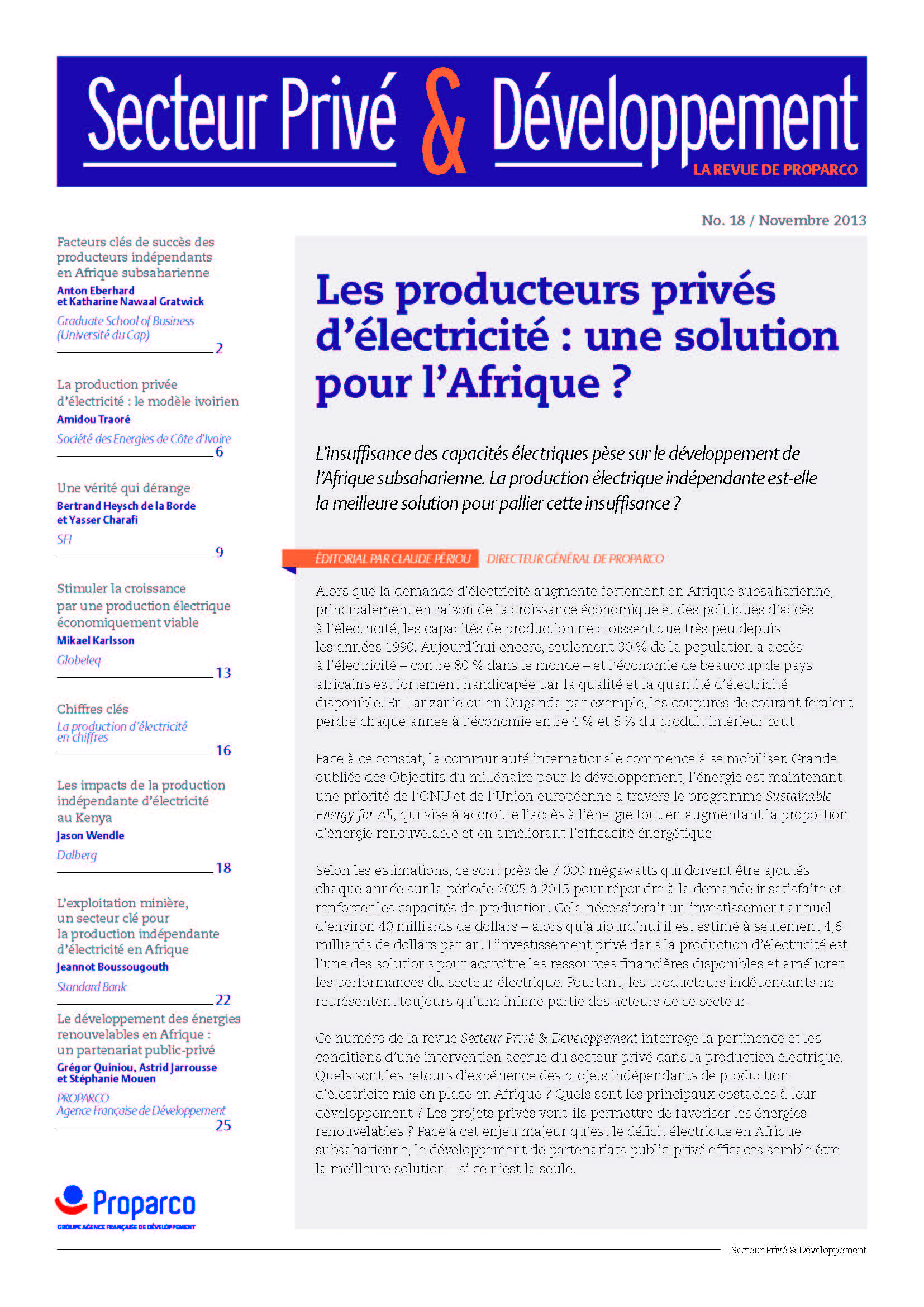Share the page
Driving growth by providing economically sustainable power
Published on


Private Sector & Development #18 - Independent power producers: a solution for Africa?
This issue explores the benefits and the requirements of increased intervention in electricity production by the private sector. Developing efficient public-private partnerships would seem to be the best solution for confronting the major challenge of sub-Saharan Africa’s energy deficit.
Globeleq focuses on independent power projects (IPPs) in the emerging markets of Africa and Central America. The company is dedicated to enabling growth; the good performance of its operations; delivery of its projects on time and on budget; and participation in future development opportunities. It aims to help countries drive economic growth by providing economically sustainable electricity, using established IPP processes, such as those developed in Kenya, Nigeria and South Africa.
Globeleq was formed in 2002 to focus on independent power projects (IPPs) in emerging markets. At that time, most believed aid was a necessary part of developing the African continent and reducing poverty. Over time, however, a slow but general realisation has emerged that change would best come through the creation of economically-sustainable businesses which support economic development through private investment. Some countries have successfully created a suitable environment for private investment that encourages growth, some are working on it, others, though, have not made changes. The fact remains, however, that demand for energy outstrips supply, holding back economic development over much of the continent.
Leading independent power projects in Africa
Globeleq has rapidly expanded its activities in the past two years, undertaking construction of 520 MW of new generation capacity and begun the 139 MW expansion of an existing operation. The company typically invests in assets with operating capacities of 50–500 MW and targets equity investment of USD 50-150 million per asset in its target regions. Our return targets reflect market dynamics and the risk profile of a project; where the sector is stable, government support is strong and the process clear, our return requirements are likely to be lower. The company is not constrained by technology and pursues opportunities across the whole spectrum of power plant technologies and fuel types, including renewables.
Globeleq targets countries that demonstrate commitment to private power producers through a transparent procurement process, backed by a coherent energy plan. Other investment criteria include the ability to contract long-term power-purchase agreements (PPAs), fairly priced and sustainable long-term tariffs, and credit-worthy off-takers. We try to attain majority ownership and operational control, with day-to-day commercial, operational and maintenance responsibility. Even when these criteria are met, Globeleq recognises that progressing projects can be challenging and takes time.
In Tanzania, Globeleq's Songas project was the country's first natural-gas-to-power project, fully supported by the government, sector participants, legislation, a newly appointed regulator and the World Bank. Originally scheduled to reach financial close in 1997, the project was suspended for four years when another IPP started and became marred by allegations of high-level corruption. Confidence in IPPs and the sector was eventually restored and the integrated gas-to-power facility began operation in 2004. An expansion project in 2005 has added further capacity and consequently Songas has saved Tanzania billions of dollars in imported fuel-oil costs and enabled the construction of new gas-fired generation facilities. Tanzania, however, has fewer potential investors in its power sector than Kenya due to tariffs being held below cost-reflective levels, illiquidity in the sector and sporadic payment delays.
In late 2010, Globeleq increased its stake in the 288 MW Azito plant in Côte d'Ivoire, with a view of immediately expanding and converting the facility to a more efficient combined-cycle plant. Shortly after financial close, an election was followed by six months of civil unrest, temporarily setting back much of the stability and investment climate which had existed since privatisation of the sector began in the early 1990's.
Conflict of any kind usually chases investment away. However, after it subsided, the newly elected government committed to address the country's power deficit and continued to pursue the project with industry sector participants, lenders and international investors. Construction began in February 2013 and an additional 139 MW will be added to the grid in 2015. Having a fully committed and supportive government, a dedicated industry sector with established policies, and legislation created to achieve long-term sustainability, ensures this and other IPP's on-going success. Globeleq looks for projects in markets with government support – both from a political and contractual perspective. Another area is the long-term participation of multi-lateral and bilateral development agencies in the projects. Often their participation is non-negotiable – outside of South Africa it is hard to find long-term finance other than from these institutions – but the corollary is the political halo created by their participation.
Contrast with Central America
In Central America, where Globeleq's majority-owned subsidiary, Globeleq Mesoamerica Energy is the region's leading wind-energy producer, its investment criteria and IPP principles are similar.
The development of the energy-sector in this region is very different from in Africa, with private power driving growth. On average in the region, an estimated 63 per cent of energy generation is provided by approximately 20 IPPs. Compare this to markets in Africa where Kenya and Nigeria lead the way with four or five significantly sized IPPs. The success of IPPs in Central America has been driven largely by government commitment to the private sector as the primary driver of the energy sector, and to associated transparent procurement processes together with the sustainable regulation required for long-term success. In addition, renewable energy in Central America is high on the agenda with an ample supply of natural resources and a commitment to sustainable energy development. This is reflected in renewable-specific structuring mechanisms such as net metering, economically viable feed-in tariffs and robust renewable-energy production laws. Though Africa has equally abundant renewable resources, many countries are yet to put in place economically-viable feed-in tariffs or to structure processes specifically aligned to renewable projects.
African specificities
Africa has historically been the slowest moving of Globeleq markets, with continuing sector economic problems across the majority of the continent. There are, however, signs of change with South Africa, Nigeria and Kenya formally recognising the need for private-sector investment. When the South African government launched its Renewable Energy IPP Procurement Programme (REIPPP) in 2010 to add 3,725 MW to the national grid with aggressive first-round bid deadlines, the perceived challenges would have daunted any seasoned IPP developer. But the process was successful – 28 new renewable power projects with a capacity of 1,416 MW were awarded in the first round. Of these, Globeleq and its consortium members were successful in the 138 MW Jeffreys Bay Wind Farm and the 50 MW Droogfontein and 50 MW De Aar solar power projects. The REIPPPP is being lauded around the world as revolutionary with the first two rounds1 mobilising USD 9.5 billion of investments, mainly provided by the private sector.
Why did it work so well? The government fully supported the initiative and established a transparent process with clear guidelines, ensuring the best technical, legal and project finance advisors were assigned to the programme. Strong treasury support – effectively a guarantee of the public utility's obligations – gave lenders and sponsors investor confidence. To ensure power was competitive, affordable and sustainable, South Africa opted for a competitive-bid process rather than a feed-in tariff. Additionally, the provision of standardised bilateral agreements included a long-term PPA with the national utility. Social and economic development targets were built in to the deal, ensuring local rural communities benefit from each renewable project.
In Nigeria, privatisation and restructuring of the electricity sector has huge potential. With around 170 million people, yet with an installed capacity of only around 4,000 MW, most people rely on self-generation. After years of false starts, broken promises and corruption, the sector seems to be moving in the right direction with various initiatives and bodies set up to attract private investors.
In 2012, the government approved USD 2.3 billion in bids for generation and distribution. Power produced will be purchased through long-term PPAs with the Nigerian Bulk Electricity Trading Company, backed by risk guarantees provided by the World Bank. A multi-year tariff order has been put in place to move tariffs to cost-reflective levels in the medium term, with the availability/reliability of supply through long-term gas-supply arrangements a work in progress. There are substantial hurdles still to be overcome, so only time can tell whether this renewed political impetus will be carried through to a successful privatisation and restructuring of the sector.
Relying on hydro- and thermal-power generation, Kenya has set goals, with supporting legislation, to diversify its renewable energy portfolio by adding geothermal –1 GW over next 3–5 years – and wind energy. It has introduced feed-in tariffs for renewables and the programme is well supported by the World Bank and the African Development Bank. Competitive tenders for geothermal plants are being overseen by the Geothermal Development Corporation and Kengen, the dominant majority state-owned generation utility, both of whom seek to work within the established feed-in tariff for geo- thermal power.
Main hurdles
Aside from these three African economic powerhouses, energy-sector procurement programmes are still slow and lack transparency. Even countries with enormous energy resources continue to have electricity shortfalls. There are three main ways of procurement – bid, feed-in tariffs and bilateral regulated. All can be successful but only if there are transparent, clear processes backed by legislation. Full commitment and understanding by government in support of financially-healthy energy sectors and private sector participation needs to be present, while tariffs must be cost and risk reflective.
Generally, the sector remains extremely political with some countries insisting that government-owned utilities be responsible for power-sector growth, alongside subsidised tariffs. Transparent processes and legislative frameworks and mechanisms to create favourable private-investment environments are non-existent in many countries, as is the existence of credit-worthy off-takers. Securing the support of financial institutions and the confidence of private investors still requires credit support from, for example the Multilateral Investment Guarantee Agency, and the International Development Association's Partial Risk Guarantee. Globeleq assesses the level of credit support on a project-by-project basis, taking the risks of the project and the sector into account.
In addition, there is an underlying perception that international investment results in little or no benefits for the local economy. This is palpably not true when one takes into account the substantial direct and indirect benefits of providing reliable and sustainably-priced energy otherwise not available to energy hungry markets, thus driving economic and social growth. The South African REIPPP has shown that specific socio-economic development targets can be secured if well planned.
Looking forward
Globeleq is optimistic for the future of sub-Saharan Africa and believes that currently there is a slowly emerging turning point for Africa's power sector. The company is committed to playing its part in continuing growth; the good performance of its existing operations; near-term delivery of its projects under construction on time and on budget; and participation in future development opportunities.
In the short term, with the right investment environment already in place, Globeleq is looking forward to the continued success of South Africa's REIPPP. All indicators point to good progress for restructuring of the power sector in Nigeria and further opportunities being made available through the bid process in Kenya. More broadly, it is hoped other countries in sub-Saharan Africa will benefit by following the successful processes of these three countries and enabling procurement of more IPP projects to provide economically sustainable electricity, driving economic growth across the continent.
1 The second round has been completed in May 2013 with 19 projects totaling 1 044MW
Author(s)
Mikael Karlsson
CEO
Globeleq

